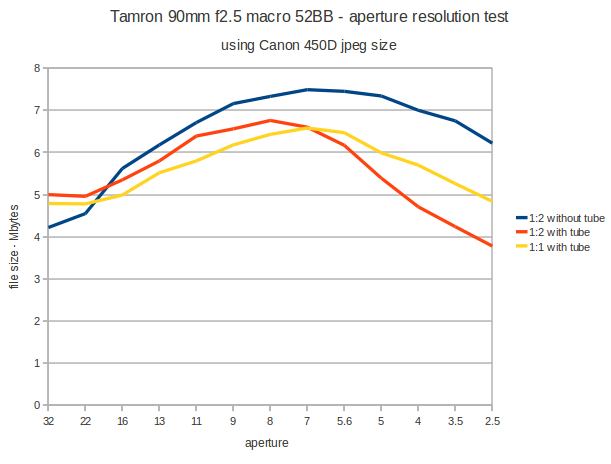 Posted: Thu Jul 08, 2010 12:26 am Post subject: Tamron macro SP 90mm f2.5 - some results Posted: Thu Jul 08, 2010 12:26 am Post subject: Tamron macro SP 90mm f2.5 - some results |
 |
|
lorriman wrote:
Well I received the 90/2.5 macro lens, 52BB version with BBAR multicoatings (for what that's worth, not much). Mint condition as far as I can tell, which was a nice surprise.
Flare problem: affecting modern AF 90mm f2.8 Di Tamrons also
My concern (see previous post) was a blue sensor flare that is reported to appear under certain lighting conditions (bright lights) at the very apertures that I wish to use for taking digital pics of my 35mm film negatives (rather than getting a scanner). Surprisingly I've seen this flare in pics of candles taken by the AF Tamron 90/2.8 Di which is supposed to have special digital coatings specifically to avoid such a problem. The Canon tested alongside didn't exhibit the problem (as you can see in that link).
The sad news is that yes, the 450D's CMOS sensor is reflective enough to make that flare appear. I had hoped that the supposed lesser reflectivity of CMOS versus CCD would be in my favour.
(I was also looking at the possibility of definitively avoiding this problem by getting the Takumar SMC 100mm f4 but ominously someone has mentioned getting flare under certain lighting conditions, but no details or examples. Darn it. I also have no idea of it's resolution - is it really worth the trouble and expense - except for anecdotal "extremely sharp" reports. No MTFs or even lp/mm's.)
Possible solution
According to Adaptall-2.org resolution tables the 52BB lens (a cosmetic upgrade to the 52B) has it's peak at f11 for 1:2 which is my negative shooting magnification. That's a real pain since the flare is prominent at f11, and I suspect will appear if I have sufficient darks in my film pics (though the orange mask may help as I think Nestter mentioned). However since these tables are for full frame film and matters change with crop (Canon 450D, 1.6x) I thought to do my own resolution test to see if the ideal aperture changed, and my luck. the flare is very faint at f5.6, for example.
I also wanted to see if adding the 1:1 tube changed the flare. Apparently the flare disappears with the 2x extender but I don't have that. I was presuming that the tube wouldn't change matters as the lenses would be in the same place but wonderfully the rear lens group (which has been blamed for this phenomena) is fixed, for close range correction, and doesn't move and so it does end up further away from the sensor at the same 1:2 magnification when the tube is added. That could make the difference.
Bittersweet results
The good news is that with the tube the flare completely disappears. The bad news is here:

This is a primitive resolution test to attempt to discover the sharpest aperture on my brother's 450D. Carefully focussing and adjusting exposure I've measured the resulting file size at each aperture (some of the in-between apertures are guesses: f7 could be f6.5). This monstrous methodology will serve to give an answer to my questions, excite the excitable and offend anyone who knows what they are talking about (which I sure don't). Of course I would prefer to do a full Imatest (or whatever it's called) but at this magnification there's not much chance of that for this crazed amateur.
Visual inspection confirms the graphs; but I do prefer (quasi) objective findings. I'll post some pics soon.
The 1:1 test isn't really equivalent to the other two as the extra magnification means the test target (some blank card) is significantly changed in appearance and probably detail and so the supposed drop in resolution means nothing but it's nice to know the best aperture.
It's not all bad
Anyway, as you can see with the extender tube I get a resolution hit at 1:2. Darn. I'll see how those negatives weather it sometime. The good news is that the optimal aperture without the tube on the 450D appears to be f7, not f11 as on fullframe, and even f5.6 may be acceptable though corners may be an issue as the flat field is really at optimum aperture according to the old tables. At that aperture the sensor flare is much less likely to appear (though it can indeed appear despite reports to the contrary; perhaps they were done on fullframe).
Serious mush at f2.5
I can also report that with the tube anything other than the very centre at f2.5 1:2 is total mush. Whereas without the tube you can still get a usable image at f2.5 the tube means that only the very center has any image data. Completely unusable. And this mush isn't field curvature: I can't bring it in to focus. Stopped down and things become reasonable again (eventually resolution the same everywhere). Therefore on the chart 1:2 at f2.5 with-tube is effectively the termination point for the jpeg file size for the test target I used and gives a bit of context to the rest of the chart.
Tomorrow is another day (and so is yesterday, ahem)
Tomorrow for fun I'm going to shoot an Imatest resolution target I printed out on my old laser to compare to those old resolution tables. I can already hear the dull thud of fainting purists at this unthinkable outrage. I'm also going to compare it to my czj 135/3.5.
Last edited by lorriman on Fri Jul 09, 2010 9:49 am; edited 1 time in total |
